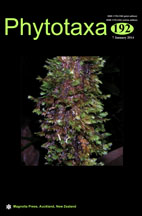Abstract
Agaricus is a genus of saprobic basidiomycetes including species of nutritional and medicinal interest. Historically the temperate species have been grouped into eight classical sections. Recent phylogenetic analyses however, revealed that two-thirds of the tropical taxa do not cluster in these sections, but form exclusively tropical clades. Seven (TR I to TR VII) strongly supported tropical clades have been revealed and it was hypothesized that clade TR I might represent Agaricus section Brunneopicti. This section was initially characterized by the presence of punctiform squamules, the remains of the veil, on the pileus and stipe. The present morphological study and phylogenetic ML, MP and Bayesian analyses based on ITS1+2 sequences show that clade TR I corresponds to Agaricus section Brunneopicti and includes 16 taxa grouped in four strongly supported subclades and two isolated branches. The six species with punctiform squamules which initially characterized the section constitute one of these subclades. We propose the new replacement name Agaricus brunneopunctatus for the illegitimate name Agaricus brunneopictus. All 16 species are discussed, full descriptions are provided for five, among them, A. brunneosquamulosus, A. niveogranulatus, A. sordidocarpus and A. toluenolens are described as new species. We also report on certain members of section Brunneopicti traits which generally characterize species belonging to other sections. These shared characters raise the issue of their origin and complicate the systematics and the identification of the tropical Agaricus species. An artificial dichotomous key is presented for species identification. Section Brunneopicti is the first reconstructed section of tropical Agaricus. Its known geographical distribution range is strictly palaeotropical. We predict that the species richness of other somewhat forgotten or new tropical sections will also increase in coming years.

